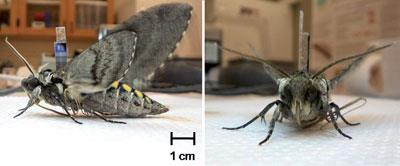US researchers control moth flight using microfluidic implants
Insects could one day fly undercover missions for the US military, under the control of chemical-releasing microfluidic implants, US researchers say.
Scientists at Cornell University in Ithaca used microfluidics to manipulate metabolism in moths, dictating when and for how long they could flap their wings. Combined with established electrical stimulation techniques which influence flapping and flight direction, the method could eventually enable scientists to gain complete control over insect flight and, perhaps, create spy bugs.

The team, led by David Erickson, are the first to implant microfluidic chips into insects. The chips, each one as big as a moth’s head, are filled with chemicals intended to paralyse the insects for short periods - so whilst older electrical techniques can be used to control wing motion, this new chemical method could work like an on-off switch for the insect. One of the most effective chemicals is the neurostransmitter gamma-aminobutyric acid (GABA), a component of spider venom.
A chip is implanted into the thorax - the "belly" - of the insect just before it transforms into an adult moth. When the moth matures two days later, the team filled the chip with chemicals, to 15 per cent of the insect’s body weight. Applying an electric potential triggers release of the chemical into the moth’s body - and rapid immobilisation. GABA can immobilise an insect within a minute and prevent it from flying for two hours.
According to the researchers, only around a third of the insects are able to fly following the chip-implantation procedure - fewer if the chip is implanted too early. But the vast majority survive the implantation process and, after injection, all regain complete control of their functions in under a day.
The insects used in the study are a species of tobacco hornworm moth with a large wingspan (10cm) and flight range of kilometres, making them perfect for reconnaissance and dangerous missions. Intriguingly, Erickson is unwilling to disclose further details of his research, which is supported by the US defence agency, DARPA.
’The researchers raise the idea of being able to use these insects to go into hazardous areas and check things out,’ says Jon Harrison, an insect flight specialist at Arizona State University. ’These moths can be trained to detect all different kinds of chemicals, so they could be used to find explosives or fly out and land on buried landmines.’
Harrison thinks an integrated approach, using chemical and electrical techniques, is needed in order for the idea to find real applications. But as he points out, at present, the researchers only inject chemicals that shut the insects down. ’It would actually be more useful to have chemicals that would promote flight rather than stop it - just because an insect isn’t immobilised doesn’t necessarily mean it’s going to fly,’ he says.
Hayley Birch
Enjoy this story? Spread the word using the ’tools’ menu on the left.
References
A J Chung and D Erickson, Lab ChipDOI: 10.1039/b814911a






No comments yet